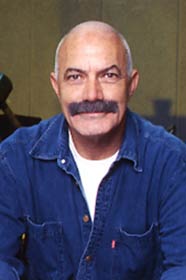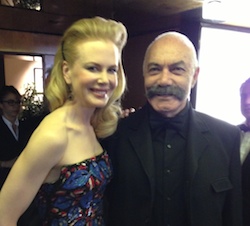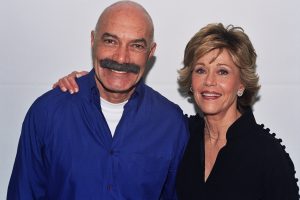Youth Without Youth marks the return of a majaor filmmaker confronting philosophical questions with candor, gravitas, and intriguing images. Based upon the novella by Mircea Eliade, author and acclaimed historian of religion, Youth Without Youth stars Tim Roth, Alexandra Maria Lara, Bruno Ganz and newcomer Alexandra Pirici.
Oscar-winner Francis Ford Coppola (“The Godfather” movies) made the adaptation, which is his first film in a daecde. The film was shot in Romania with a native crew—the only exceptions being exec producers Anahid Nazarian and Fred Roos, editor Walter Murch, and hair and makeup designers Peter King and Jeremy Woodhead. The cinematography is by Mihai Malaimare, Jr., production design by Calin Papura, and original score from the eminent composer Osvaldo
Golijov.
In Youth Without Youth Tim Roth plays Dominic Matei, an aging professor of linguistics who survives a cataclysmic event to find his youth restored. Dominic's physical rejuvenation is matched by a highly evolved intellect, which attracts the attention of Nazi scientists, forcing him into exile. While on the run, he reunites with his lost love, Laura, and works to complete his research into the origins of human language. When his research threatens Lauras well being, Dominic is forced to choose between his lifes work and the great love of his life.
Origins of the Project
I was first made aware of Youth Without Youth by a friend from high school, Wendy Doniger. She did me the favor of reading a screenplay Id been working on for many years, Megalopolis, without being able to complete. I had a hunch that Wendy, now an eminent professor of South Asian Studies at the University of Chicago, could shed light on some of the difficult concepts in the story—and she did. We discussed the two areas of film language which have always intrigued me, time and interior consciousness.
Her reaction to the screenplay was encouraging. More significantly, she also enclosed some intriguing lines from Youth Without Youth, a novella written by her mentor Mircea Eliade. I decided to read the story itself. Soon after starting, I suddenly thought: I can make this into a movie. I wont tell anyone. Ill just start doing it.
Personal Film
The story touched my life. Like its leading character, Dominic, I was tortured and stumped by my inability to complete an important work. At 66, I was frustrated. I hadnt made a film in eight years. My businesses were thriving but my creative life was unfulfilled. Youth Without Youth was, in a way, like The Twilight Zone an old man, a professor, becomes young again. He seizes that extra time to continue his research on the origins of language. I wanted to return to personal filmmaking. That meant low budgets.
Faustian Tale
You can enjoy the film like a Faust story. An old man gets young, has an opportunity to finish his great work and fall in love again, but cant finish the work because of love–that is his ultimate sacrifice. But it can also be educational opportunity to learn more about Eastern philosophy.
Twists and Turns
I loved the way one darned thing after another kept happening. Sent to a clinic to recuperate, Dominic has erotic dreams, which turn out to be nightly romps with another guest–The Woman in Room 6. But things are not what they seem. The pretty, young thing turns out to be a spy, in cahoots with eugenic scientists who are Nazis! One day she disappears. SS officers come for Dominic. The Professor holds them at bay long enough to prepare a phony passport and send his
patient into exile to Switzerland, a neutral country.
Shooting in Romania
This story was set in Romania. Ive always liked getting out of the center of things; moving from L.A. to San Francisco was the same. So very much on the sly, I began negotiating to buy rights to the novella. I started thinking about how I would make the movie even though I didnt yet have a movie to make. I got a
notebook and started to break down the novel. Suddenly there was hope. I already had the camera and had recently bought a set of jewel-like lenses, yet I had no movie to make.
Approach and Style
I began to theorize on a style. Like the great Japanese director, Ozu, I wouldnt move the camera. Thats hardly original, and only a beginning style, but perhaps my explorations of time and inner consciousness could contribute a few new words to the vocabulary of cinema. This was something I had long yearned to do.
My spirits soared. When I went out with my family or my friends, I felt better because I had a secret no one knew about – a movie brewing. When the script was finished, I went to Romania with my granddaughter, Gia. We stayed at the home of an American friend whod bought control of a clunky old pharmaceutical company, which he was turning into a European Union-compatible business.
Keeping It Simple
This gave me cover: I was anxious not to get ensnared as a famous film director with a big budget. Gia and I traveled around Romania, going to all the real addresses in the story. It was fun and adventure. Little by little, I was cooking up a scheme to make a movie, which I could finance myself. It was a relief not to have to go hat-in-hand to moneymen or studio bosses.
I kept everything simple. When I knew this could work, I brought over two trusted colleagues, Anahid Nazarian and Masa Tsuyuki–and the camera. I began testing actors in a backroom of my hosts pharmaceutical company. There are over 50 roles in Youth Without Youth. How many could I cast right there
Choosing Cinematographer
But I had an even more elaborate scheme: each time I shot a test with an actor, Id use a different photographer. They were all fine but I chose Mihai Malaimare, Jr. The movie was about becoming young again. I liked the fact that Mihai was so young, had a gentle personality, and was tremendously talented. When I told him the camera would remain stationary throughout, he said thats great!
Anahid had produced a couple of low budget films and done a great job. I wanted to keep the crew small. Wed double up. Anahid would be both producer and script supervisor. Equipment-wise, Id use only what was absolutely necessary. Masa went back to Napa and bought a Dodge Sprinter, which he turned into a studio-on-wheels, a van which would carry all the equipment. We shipped it to Romania. Now Im about to jump off the cliff.
The Shoot
We began filming in October of 2005 and shot for 85 days with a predominantly Romanian cast and crew. I learned a lot from Mircea Eliade just by traveling in his footsteps. Ive always felt that if youre working on a film whose themes interest you, the sheer act of making it ensures that you learn. When I read the story, I knew that if I made the movie Id learn how to express time and dreams cinematically. Making a movie is like asking a question, and when you finish, the movie itself is the answer.










